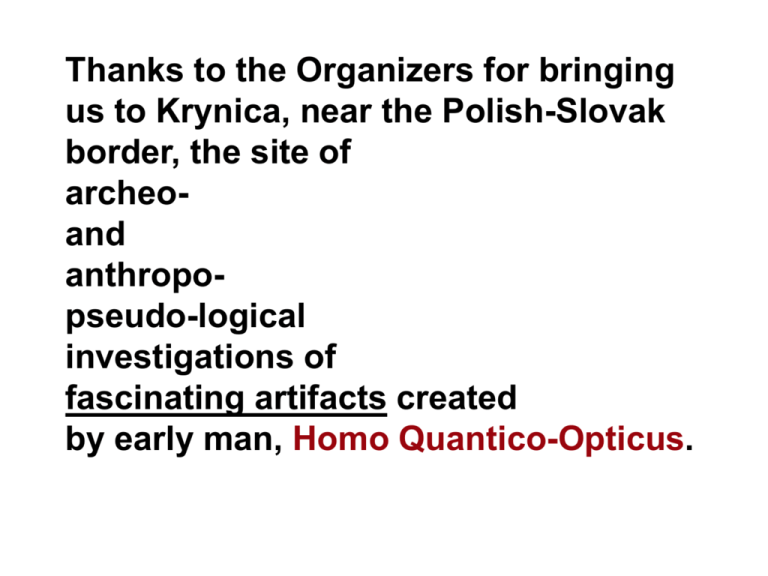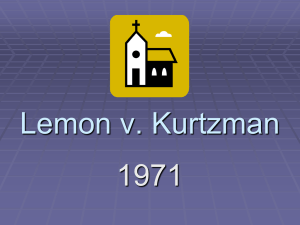ppt
advertisement

Thanks to the Organizers for bringing
us to Krynica, near the Polish-Slovak
border, the site of
archeoand
anthropopseudo-logical
investigations of
fascinating artifacts created
by early man, Homo Quantico-Opticus.
Homo QuanticoOpticus.
Who were these
ancient peoples?
What is their
record?
Written
scripts
have been
found
and
interpretations
are
being
attempted.
Written
scripts
have been
found
and
interpretations
are
being
attempted.
Written
scripts
have been
found
and
interpretations
are
being
attempted.
Even
more
amazing,
pictorial
records of
shocking
clarity
have come
to light.
We have met the ancients,
And they are us!
From Chap. 12, Sec. 12.5, of Nielsen &
Chuang:
“…it seems fair to say that the study of
entanglement is in its infancy, and it is
not entirely clear what advances … can
be expected as a result of the study of
quantitative measures of entanglement.
We have a reasonable understanding of
the properties of pure states of bipartite quantum systems, but a very
poor understanding … even of mixed
states for bi-partite systems.
Developing a better understanding of
entanglement … is a major outstanding
task of Q.C. and Q.I.”
Quantum Entanglement implies a superposition of
conflicting information about two objects.
Superposition of
conflicting information,
but only one object.
Can you
handle the
conflicting
information
here?
Which face
is in the
back?
A pair of conflicts can be “entangled”
Try to see both at the same time.
Do they “flip” together?
Measurement cancels contradiction
A pair of boxes, but only one view of them
Work on Three Entanglement Themes
Einstein-Podolsky-Rosen
•K.W. Chan, C.K. Law & JHE, PRL {88}, 100402 (2002)
•K.W. Chan, C.K. Law & JHE, PRA {68}, 022110 (2003)
•JHE, K.W. Chan & C.K. Law, PTRS London A 361, 1519 (2003)
•K.W. Chan, et al., JMO {51}, 1779 (2004)
•M.V. Fedorov, et al., PRA {69}, 052117 (2004)
•K.W. Chan and JHE, quant-ph/0404093
•M.V. Fedorov, et al., PRA (under review 2005)
Parametric Down Conversion
•H. Huang & JHE, JMO {40}, 915 (1993)
•C.K. Law, I.A. Walmsley & JHE, PRL {84}, 5304 (2000)
•C.K. Law & JHE, PRL {92} 127902 (2004)
Qubit Decoherence
•Ting Yu and JHE, PRB {68}, 165322 (2003)
•Ting Yu & JHE, PRL {93}, 140404 (2004)
•Ting Yu and JHE, quant-ph/0503089
From Chap. 12, Sec. 12.5, of Nielsen &
Chuang:
“…it seems fair to say that the study of
entanglement is in its infancy, and it is
not entirely clear what advances … can
be expected as a result of the study of
quantitative measures of entanglement.
We have a reasonable understanding of
the properties of pure states of bipartite quantum systems, but a very
poor understanding … even of mixed
states for bi-partite systems.
Developing a better understanding of
entanglement … is a major outstanding
task of Q.C. and Q.I.”
Our
focus
today
Quantum Optics VI
Krynica, Poland / June 13-18, 2005
Sudden Entanglement Death,
and Ways to Avoid It
J.H. Eberly and Ting Yu
University of Rochester
Overview of talk
Issues -- how does inter-party entanglement behave in a noisy
environment? What is Sudden Death? Can it be overcome?
Guiding principle -- find illustrations so simple that new
results come from fundamentals rather than complications.
Specific example -- take two qubits in an standard mixed state
where no DFS exists, and then turn on vacuum noise.
Results -- local decay is exponential as exp(-t/2), but nonlocal decay has several channels, including Sudden Death.
Consequence -- entanglement can be more fragile than can
be estimated from qubit lifetimes.
Ting Yu & JHE, PRL 93 140404 (2004) and arXiv: quant-ph/0503089
1.0
Entanglement vs. time
0.5
Noisy
environment
0.0
time
Qubit
A
Remotely
entangled
but not
interacting
Qubit
B
Noisy
environment
1.0
0.5
Entanglement vs. time
?
Noisy
environment
0.0
time
Remotely
entangled
Qubit
A
and still not
interacting with
each other
Qubit
B
Noisy
environment
Two atoms--simplest example:
Atoms A and B are partly excited, in broad-band cavities, and undergo
spontaneous emission without back reaction or J-C behavior.
A
B
HAT = (1/2)wAsZA + (1/2) wBsZB , HCAV = k (wkak†ak +nkbk†bk)
HINT = k(gk*s-Aak† + gks+Aak) + k(fk*s-Bbk† + fks+Bbk)
The interactions give standard Markovian decay. The mixed initial state is
taken entangled. The atoms can only decay, and don’t interact with each other.
After t=0, what happens to local coherence? To non-local entanglement?
Entanglement 101 - Hamiltonian & state
• Bipartite system:
•
•
H HA HB
The state is separable when
p i iA iB .
i
There is a “standard” form for two-party
states:
a 0
0 b
AB
0 z *
0 0
0
z
c
0
0
0
0
d
• It is form-invariant under both phase and
ampl. noises: a -> a(t), 0 -> 0, etc.
Entanglement 102 - measures of ent.
Find degree of ent. via Schmidt number, Entropy of formation, Concurrence . . .
Concurrence* applies to bipartite mixed and pure
states, and is sensibly normalized: 1 ≥ C ≥ 0.
C( ) max 0,
1 2 3 4
where 1 2 3 4 are the eigenvalues of the matrix:
(s yA s yB ) (s yA s yB )
Here denotes the complex conjugate of in the
standard basis and s is the Pauli matrix expressed in
y
thesame basis.
*W. K. Wootters, PRL 80, 2245 (1997)
Entanglement 103 - examples of concurrence
• Arbitrary
pure state
AB
a1 a2 a3 a4
C() 2 | a1a4 a2a3 | .
a
0
• Standard
0
mixed state
0
| z | 0, C() 0,
0
b
z*
0
0
z
c
0
& also if
0
0
,
0
d
C( ) 2 max | z | - ad , 0
| z | ad, then C() 0.
Specific calculation with mixed state at t=0:
a
1 0
(a)
3 0
0
0
1
1
0
0
0
1
0
1
0
0 1 a
1
The concurrence at t=0
varies with parameter “a”
between 2/3 & 1/3
Ca(0) vs. a
2/3
1/3
0
0
a
1
Master eqn. sol’n. in Kraus representation:
(t) =
K (t) (0) K†(t)
Two-qubit vacuum-noise Kraus operators:
A
K1
0
0 B
1 0
0
1
0
K 3
w A
0 B
0 0
0
1
A
K 2
0
0 0
1 w B
0
0
0
K 4
w A
0 0
0 w B
0
0
A B exp(t /2), and w A w B
1 exp(t)
For example, see T. Yu and J.H. Eberly, Phys. Rev. B 68, 165322 (2003), Sec. III.
Entanglement + noise gives Sudden Death (?)
0.7
0.6
a
1 0
(a)
3 0
0
a=0
0.5
0.4
C(t) 0.3
0
1
1
0
0
0
1
0
1
0
0 1 a
a=1
0.2
always finite
0.1
Sudden
Death
0
0
0.5
1
1.5
2
2.5
3
time in units of t0 = 1/
graph by B.D. Clader
Entanglement time dependence as a function of the
interpolation parameter “a”:
a
1 0
(a)
3 0
0
0
1
1
0
0
0
1
0
1
0
0 1 a
tSD= ln(1+1/√2)
graph by Curtis Broadbent
Werner states - pure coh. + pure incoh.
are important examples of standard mixed
state:
1 F 4F 1
W
I4
, where 1 F 1/4.
3 3
Werner states also exhibit strange entanglement
dynamics in the presence of noise. We can calculate the
temporal response to the two “universal” noises,
amplitude and phase, for all values of fidelity F.
Werner states and Phase vs. Ampl. noise
Phase noise is less disruptive, affecting only off-diagonal elements,
while amplitude noise affects diagonal elements as well.
However, we see that under amplitude noise there is a range of
Werner states protected from Sudden Death.
Protected
range from
F = 0.714 to
F = 1.0
Pure Bell
state alone
For details: Ting Yu and JHE, quant-ph/0503089
Another important physical question:
What will happen if two or more noises are active at the
same time?
Our approach can answer this question for a combination
of spontaneous emission (amplitude noise), and phase noise.
We can show that for a single qubit, the overall coherence
decay rate is the sum of the individual decay rates, but
that for ENTANGLEMENT, the overall decay rate IS NOT
the sum of the individual decay rates. In the combination,
linear noise behaves nonlinearly for non-local coherence.
Protection by purely local operation
Local unitary operations cannot increase
the degree of entanglement (well-known):
U UA UB
However, some local operations can increase
the survivability of entangled states.
Local operation example: U is xA IB
1 F
4F 1
Before:
˜W
I4
| |
After:
3
W
3
1 F
4F 1
I4
| |
3
3
“Tilde” W state
True W state
Final
state is more
robust than the initial state !
Summary:
(a) A standard bipartite mixed state exists, and it is form-invariant
in noisy evolution.
(b) The simplest two-qubit case shows Sudden Death - that
entanglement can vanish completely and non-analytically in a
finite time.
(c) Estimates of lifetimes based on a local qubit or a single noise
cannot be relied on for entanglement lifetimes.
(d) Local operations can change the survival time of entangled
states.
(e) When two noises are active, the result can be nonlinear entanglement can suffer Sudden Death even though the noises
permit long smooth survival when applied separately.
Sudden Death of
Entanglement?
Solution: Kraus Operators
The solution for the finite temperature can be similarly expressed
in terms of 16 Kraus operators:
(t) =
Explicitly:
a 0
0 b
. 0 z*
0 0
6
0
z
c
0
0
0
0
d
M (t) (0) M†(t)
a(t)
0
0
0
0
b(t)
z(t)
0
(t)
*
0 z (t) c(t) 0
0
0 d(t)
0
a(t) = N14a+N2[a+ w2(b+c)+ w4 d]+ N3[2 2a+2 w2(b+c)];
2 w2 d]+ N [b+4b+ w2(a+d)+ w4 c];
b(t) =
N1[2b+ 2 w2 a]+ N2[2b+
3
c(t) =N1[2c+ 2 w2 a]+ N2[2c+ 2 w2 d]+ N3[c+w2(a+d)+ w4 b+4c];
d(t) = N24d+N1[d+ w2(b+c)+ w4 a]+ N3[2 2d+2 w2(b+c)]; =
z(t) = 2z, where w2 = 1 - 2, and N1 , N2 , N3 are numerical factors determined
by the mean photon number in the thermal heat bath.






